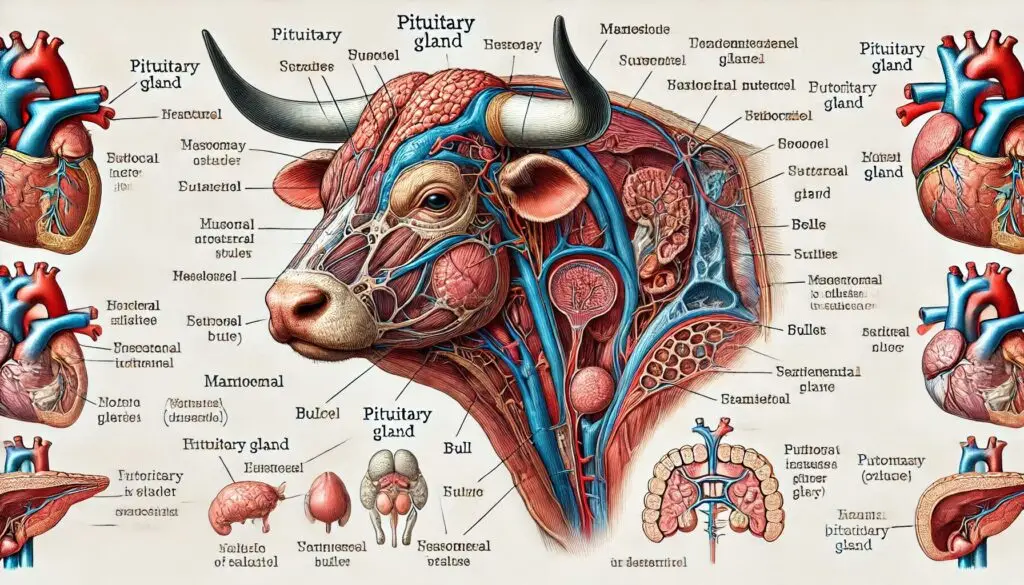Thyroid Gland in Livestock

Structure of the Thyroid Gland
The thyroid gland consists of two lobes connected by an isthmus. Its size can vary among species. For instance, cattle have a relatively wide isthmus compared to other animals like sheep or goats, where it may be narrow or absent. The gland typically weighs about 0.20% of an animal’s body weight, making it small yet significant.
Location and Functionality
Located below the larynx and around the trachea, the thyroid gland traps iodine from the bloodstream. This iodine is essential for synthesizing thyroid hormones. The primary hormones produced are thyroxine (T4) and triiodothyronine (T3), which play critical roles in metabolism and energy regulation.
Functions of the Thyroid Gland
Hormone Production
The thyroid gland’s primary function is to produce hormones that regulate metabolic processes. T4 and T3 influence how animals convert food into energy, affecting growth rates and overall health.
Metabolic Regulation
Thyroid hormones are vital for energy balance. They help livestock adapt to environmental changes by adjusting metabolic rates based on nutrient availability and physiological needs. For example, during periods of increased energy demand, such as lactation or growth phases, hormone levels rise to support these processes.
Reproductive Health
Thyroid hormones also impact reproductive functions. They regulate seasonal breeding patterns in ruminants. Adequate hormone levels are necessary for successful mating and gestation. Research indicates that T3 levels influence ovarian function and fertility rates.
Factors Affecting Thyroid Function
Nutritional Influences
Nutrition plays a pivotal role in thyroid health. Iodine is essential for hormone synthesis; without it, animals can develop goiter—a condition characterized by an enlarged thyroid gland. Selenium also supports thyroid function by aiding hormone metabolism.
Physiological States
Various physiological states can affect thyroid activity:
- Pregnancy: Hormone levels fluctuate significantly during pregnancy. Increased TSH (Thyroid Stimulating Hormone) levels occur as the body prepares for lactation.
- Lactation: Dairy cows experience changes in thyroid hormone concentrations during lactation due to energy demands.
Understanding these changes helps farmers manage livestock health effectively.
Environmental Factors
Environmental conditions such as temperature and seasonality can impact thyroid function. For instance, grazing animals may experience variations in hormone levels with seasonal changes in feed quality and availability.
Common Disorders Related to Thyroid Function
Goiter: Causes and Effects
Goiter is one of the most common disorders associated with thyroid dysfunction in livestock. It results from iodine deficiency or excessive intake of goitrogens—substances that inhibit hormone production. Symptoms include visible swelling in the neck region and reduced growth rates.
For more information on goiter in livestock, visit Veterinary Clinics.
Familial Dyshormonogenetic Goiter
This genetic disorder affects certain breeds of sheep and cattle. It results from enzyme defects that impair hormone synthesis, leading to poor growth rates and reproductive issues.
Learn more about genetic disorders affecting livestock at Animal Genetics.
Monitoring Thyroid Health in Livestock
Regular monitoring of thyroid hormone levels can provide insights into the metabolic status of animals. Blood tests can measure T3 and T4 concentrations, helping farmers identify potential issues early on.
Nutritional Management Strategies
To maintain optimal thyroid function:
- Ensure adequate iodine intake through mineral supplements.
- Monitor feed quality to prevent deficiencies.
- Consider selenium supplementation when necessary.
For guidance on nutritional management, check out Feed Management.
Environmental Management Practices
Creating a stable environment can help reduce stress on livestock:
- Provide adequate shelter from extreme temperatures.
- Ensure consistent access to high-quality feed.
Conclusion: The Importance of Managing Thyroid Health
The thyroid gland significantly impacts livestock health and productivity. Understanding its functions, influences, and potential disorders allows farmers to implement effective management strategies. By prioritizing nutrition and monitoring hormone levels, livestock producers can enhance animal welfare and improve production outcomes.
For further reading on this topic, you can explore these resources:
More from Veterinary Anatomy:
Interphase in the Cell Cycle





Responses